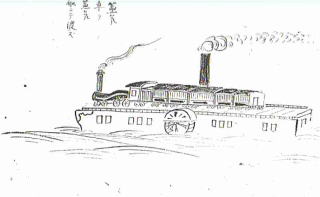|
幕末の構造改革 Structural Reforms at the End of the Edo Period |
||
|---|---|---|
|
「日本を欧米のような近代国家にするには、こういう造船所を造ることが第一歩だ」、1860(万延元)年ワシントン海軍造船所を見学した遣米使節小栗上野介はこう確信した。 After visiting the Washington Naval Shipyard as one of the envoys to the U.S. in 1860, Kozukenosuke Oguri was convinced that "the first step to make Japan a modern nation like the West is to build a shipyard like this one." The America they visited with the chonmage (topknot) style was like the
world of the movie "Gone with the Wind." Trains ran, gas lamps
lit, telegraphs transmitted information, and ferries carried trains across
rivers. The hotel fence was made of iron bars, and iron bridges could be
seen over the river. Disused iron products were thrown away on the outskirts
of towns, and no one picked them up. Oguri thought to himself, "This
country is overflowing with iron!" He fully realized that was the
reality. |
||
 |
||
| フェリー 「蒸気車を蒸気船にて渡す」:フィラデルフィア近くで河を渡った遣米使節一行 (佐藤藤七『小栗忠順従者の記録』上毛新聞社刊より) Ferry "Steam Train Carried to the Other Side of the River by Steamship Ferry" The Japanese envoys crossed the Susquehanna River near Philadelphia (From Toshichi Sato's “Tokai Nikki (Diary of Crossing the Pacific Ocean)” published by Jomo Shimbunsha) |
||
では木の国日本を鉄の国に変えるには何から手をつけたらスタートラインに立てるか、それを模索しているとき案内されたのが造船所だった。そこは製鉄を基盤として、あらゆる鉄製品を作り、出来た部品をつなぐネジも作る。黒船はまだ木造船体だから木工場もある、それら工場の向こうで「船も」作っている、要するに総合工場だった。 "How can we start to turn Japan, a country of wood, into a country of iron?" The answer to this question came from the shipyard they visited in Washington, D.C. The shipyard was based on steel manufacturing, where all kinds of iron products were made, and screws were also made to connect the finished parts. The kurofune (black ship)* had wooden hulls, so there were woodworking shops as well, and "ships" were also constructed. In short, it was an integrated factory. Note*: "Kurofune" (black ship) meant all the Western-type ships from Europe and the U.S. till the end of Edo period. The name was derived from the fact that the hulls were painted black. Five years after returning to Japan, Oguri proposed the construction of the Yokosuka Shipyard, which was constructed. It was the same comprehensive factory that they had seen in Washington. Many industrial products were produced from many factories at the Yokosuka Shipyard such as rope mills, sail mills, and lathe mills and the Shipyard became the leading center of modern Japanese industry. This is the reason why Ryotaro Shiba praised Yokosuka as "the source of Japan's modern heavy industry" in his work, “Miura Peninsula Chronicles.” 小栗の帰国後八年間はさらに忙しい。日本最初の株式会社「兵庫商社」を設立して外国商人の大資本に対抗できる商社活動を展開させ、小布施の豪商高井鴻山を説いて新潟港に船会社設立をうながし、清水喜助(清水建設二代目)に民間資本の株式会社の手法で洋式ホテル「築地ホテル」を慶応四年夏に完成させる。洋式陸軍制度を取り入れ横浜に仏人教師の指導で歩、騎、砲兵の三兵訓練所を設け訓練する。それらのために設けた仏語伝習所(横浜)で学んだ若者を、横須賀や陸軍に派遣し通訳させる。 For eight years after returning to Japan, Oguri was very busy. He established Japan's first joint-stock company, Hyogo Shosha, to develop trading company activities to compete with the large capital of foreign merchants, persuaded Kozan Takai, a wealthy merchant from Obuse, Shinshu (today's Nagano Prefecture), to establish a shipping company in Niigata Port, and had Kisuke Shimizu (the second generation of Shimizu Corporation) complete the Western-style hotel, Tsukiji Hotel, in the summer of Keio 4, using private capital joint stock company methods. He introduced the Western-style army system, and established a training center for infantry, cavalry, and artillery under the guidance of French teachers. Young men who had studied at the French Language Training School in Yokohama were sent to Yokosuka and the army to serve as interpreters. Furthermore, with the profits from the Hyogo Shosha, he proposed the installation of gas lamps, the establishment of a postal system, and the construction of a railroad between Yokohama and Edo. It is no wonder that it is said that "Kozukenosuke Oguri laid the rails for the modernization of Japan." After the collapse of the shogunate in the spring of 1871 (Keio 4), Oguri moved with his family to the village of Gonda in Jyoshu Province (today's Gunma Prefecture), one of his chigyochi territories (Chigyochi is the land given by feudal lords to their vassals), and thought about establishing a school. However, the new Meiji government forces (the Western Army) captured Oguri, falsely accused him of innocence, and killed him. The reason why Oguri's achievements are not taught in school education that began in 1872 is that the Western Army killed Oguri, his son and 6 servants and took Oguri's family property to use as funds for the army. Today, one of the screw nails that Oguri brought back from the Washington Shipyard remain in Tozenji Temple, his family temple. It was a souvenir of his desire to make the country a place where people could make more and more of this kind of thing.
|
||
| (元陸軍士官学校61期生会・第34回総会群馬大会『プログラム』寄稿・2005年10月) (Contribution to the "Program" of the 34th General Meeting of the 61st Students Association of Former Military Academy, held in Gunma, Japan - October 2005) |
||